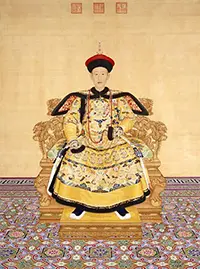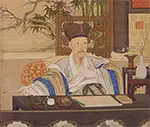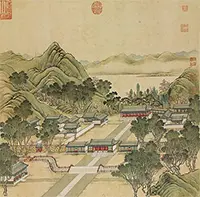China's Qianlong Emperor
The Qianlong Emperor was technically the longest-ruling head of any Chinese dynasty. Officially, though, his reign was the second-longest. During his long tenure, China enjoyed a booming economy and population and extended its geographic borders to its largest extent. 
Born Hongli, he was the fourth son of the Yongzhe Emperor. He officially became the Qianlong Emperor in 1735 and abdicated in 1796, ending his official reign at less than the 61 years served by his grandfather, the Kangxi Emperor, in order to maintain that ruler's record. The Qianlong Emperor gave way to his son, the Jiaqing Emperor, but remained the power behind the throne as the Retired Emperor until his death in 1799. Thus, his real reign was one of the longest in world history. One of the reasons that the Qianlong Emperor had such early and ongoing success was that he inherited a healthy economy and treasury, courtesy of his long-reigning grandfather and thrifty father. The new emperor used that cash flow to help finance a number of military campaigns–against northern enemies Turkestan and the Zungars, among others–and expand the borders ever further. The campaign in the north against the Zungars was particularly brutal, resulting in a near total wipeout of that ethnic population. He also sent a large contingent of troops to subdue the Miao rebellion, in the southwest. 
Like his father and grandfather, the Qianlong Emperor looked beyond his borders for inspiration and riches, not only in money but also in culture. The emperor was quite fond of painters and poets, and a combination of the two benefited from the royal patronage. The emperor took favorite paintings with him when he toured the realm. The emperor himself was an accomplished writer, composing hundreds of poems during his reign. At the same time, the emperor encouraged foreign imports, of necessities like food and ordinary goods and also of works of art, clocks, and even toys. The Qianlong Emperor used his authoritarian power to control much of society. Midway through his reign, he decided to put his imperial stamp on the art and literature being produced within his realm. Art works that gained the royal approval entered the imperial collection and their creators enjoyed royal favor; on the other hand, art works that displeased the emperor were put away if not destroyed and their creators imprisoned and/or victims of violence. 
Much of the royal money went to construction as well, with the emperor commissioning the construction of numerous palaces, including the famous Yuanmingyuan (Old Summer Palace), which grew to be much larger than the Forbidden City. Like so many of his predecessors, the Qianlong Emperor had his favorites at court. One of the most prominent was a man named Heshen, who convinced the emperor to appoint many of Heshen's associates to positions of great power. Heshen himself gained immense wealth. In 1795, the emperor, still in relatively good health, decided that he would not reign longer than his revered grandfather, the Kangxi Emperor. Instead, the Qianlong Emperor stepped aside and named one of his sons to succeed him. Officially, that son became the Jiaqing Emperor. Officially, the new emperor had only a ceremonial role; the Qianlong Emperor retained all of the real power of the office and remained so for four more years, until his death. |
|
Social Studies for Kids
copyright 2002–2024
David White




